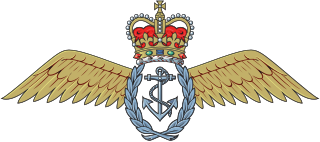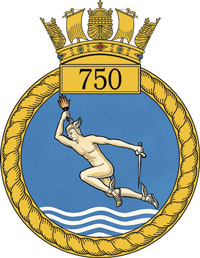 W
WThe Fleet Air Arm (FAA) is one of the five fighting arms of the Royal Navy and is responsible for the delivery of naval air power both from land and at sea. The Fleet Air Arm operates the F-35 Lightning II in a Maritime Strike Role, the AW159 Wildcat and AW101 Merlin in both Commando and Anti-Submarine roles, and the BAE Hawk in an aggressor role.
 W
WAn Aircraft Handler is a member of the Aircraft Handling branch in the Royal Navy of the UK Armed Forces. Aircraft Handlers are responsible for the safe movement, launching and recovering (landing) of all aircraft onboard ships within the Royal Navy and some of the Royal Fleet Auxiliary. They are also responsible for aircraft crash rescue fire fighting duties on board Royal Navy ships and at Royal Naval Air Stations. The Aircraft Handling branch of the Fleet Air Arm in the Royal Navy was formed in 1945. Beforehand the duties of Aircraft Handlers were performed by members of other branches of the Royal Navy, many of whom transferred to the new branch upon its formation."Specialist aircraft handling, crash rescue and fire fighting are required at sea on all ships with aircraft embarked. These skills are provided by the Aircraft Handler ratings who are also employed ashore for fire fighting duties, principally at Royal Naval Air Stations." – MOD (Navy)
 W
WThe Wildcat Demo Team are the Royal Navy's helicopter display team. The team is composed of two AgustaWestland Wildcat HMA.2 anti-submarine and anti-shipping helicopters, with the aircraft and crews drawn from 825 Naval Air Squadron based at RNAS Yeovilton in Somerset.
 W
WThe Royal Navy was active in East African waters from the 1850s to the 1960s.
 W
WThe Fleet Air Arm Museum is devoted to the history of British naval aviation. It has an extensive collection of military and civilian aircraft, aero engines, models of aircraft and Royal Navy ships, and paintings and drawings related to naval aviation. It is located on RNAS Yeovilton airfield, and the museum has viewing areas where visitors can watch military aircraft take off and land. It is located 7 miles (11 km) north of Yeovil, and 40 miles (64 km) south of Bristol.
 W
WThe Hal Far Fighter Flight was a British fighter unit formed during the Siege of Malta in 1940. For several weeks, the island of Malta was protected by a small force of Gloster Sea Gladiator biplane fighters, based at RAF Hal Far, which was also known as the Fleet Air Arm station HMS Falcon. The flight is the source of the myth that only three aircraft, named Faith, Hope and Charity formed the fighter cover for the island. In fact, six aircraft were operational, though not always at the same time; others were used for spare parts. The names Faith, Hope and Charity were applied to the aircraft many months later, by a Maltese newspaper.
 W
WOperation Lentil was an air raid by British carrier-based aircraft on oil installations at Pangkalan Brandan, an important centre for Indonesian oil production on Sumatra on 4 January 1945. It was part of the larger Operation Outflank, and its aim was to disrupt fuel supplies to Japanese forces in the Pacific.
 W
WThis is a list of Naval Air Stations of the Royal Navy. Naval Air Stations are land bases of the Fleet Air Arm, the branch of the Royal Navy responsible for the operation of naval aircraft.
 W
WThe United Kingdom operated the McDonnell Douglas F-4 Phantom II as one of its principal combat aircraft from the 1960s to the early 1990s. The UK was the first export customer for the Phantom, which was ordered in the context of political and economic difficulties around British designs for the roles that it eventually undertook. The Phantom was procured to serve in both the Royal Navy's Fleet Air Arm (FAA) and the Royal Air Force in several roles including air defence, close air support, low-level strike and tactical reconnaissance.
 W
WMobile Operational Naval Air Bases (MONABs) were a series of mobile units first formed in 1944 to provide logistical support to the Fleet Air Arm aircraft of the Royal Navy's British Pacific Fleet towards the end of World War II.
 W
WThe 1946 Rabat Vickers Wellington crash was a military aviation accident that occurred in Malta on 5 April 1946 when a Vickers Wellington bomber crashed during a training exercise in a residential area in Rabat. All four crew members on board the aircraft and 16 civilians on the ground were killed. The crash also caused extensive property damage. The exact cause was never conclusively determined, but a magisterial inquiry suggested that leakage of hydraulic fluid leading to crew incapacitation could be a probable cause.
 W
W727 Naval Air Squadron is a squadron of the Royal Navy Fleet Air Arm. It was formed in 1943 as a Fleet Requirements Unit, being disbanded in December 1944. It was reformed twice in the 1940s and 1950s to provide flying experience for naval officers. The current squadron was created on 6 Dec 2001 from the Royal Naval Flying Training Flight. It operates the Grob Tutor, with its primary role to provide grading and legacy-Elementary Flying Training for Royal Navy and Royal Marine pilots under training. It also supports the Royal Navy's "Flying Start" flying scholarship scheme.
 W
WThe Royal Navy Historic Flight (RNHF) was the historic flight of the Fleet Air Arm of the Royal Navy up until its disbandment in March 2019. The RNHF maintained and flew a small number of aircraft that were important to British Naval aviation. The organisation was not part of the military establishment; it had charitable status and was staffed by civilians. It was based at RNAS Yeovilton and provided aircraft for air displays.
 W
WThe Royal Navy Observer School grew out of HM Naval Seaplane Training School at RNAS Lee-on-Solent as a result of a series of changes of identity and parent unit. From 1918 until 1939 the Royal Air Force was responsible for naval aviation, including training and provision of aircrew to the Royal Navy. With the return of naval aviation to the Royal Navy on 24 May 1939, the Observer School was established as 750 Naval Air Squadron of the Fleet Air Arm. During World War II the squadron moved to Trinidad to continue training aircrew. It was temporarily disbanded in October 1945. The squadron reformed in 1952 and is currently based at RNAS Culdrose, where it trains approximately 30 Royal Navy observers every year.
 W
WSimon’s Sircus was an aerobatics display team comprising six Sea Vixen FAW2 aircraft from 892 Naval Air Squadron of the British Royal Navy's Fleet Air Arm. The team operated during the summer of 1968 and was named after 892 Squadron’s commanding officer at the time, Lt Cdr Simon Idiens RN.
 W
WWingfield Aerodrome was first the Cape Town Municipal Aerodrome, then Air Force Station Wingfield under the SAAF, before being used as a Fleet Air Arm base by the Royal Navy. After World War II, the aerodrome reverted to being the municipal airport for a while. The history of Wingfield is synonymous with the history of flight in South Africa, including pioneering attempts at commercial aviation.
 W
WWoy Woy Aerodrome was an aerodrome constructed in 1942 as a dispersal ground and landing ground for the Fleet Air Arm of the Royal Navy at Woy Woy, New South Wales. The airfield was built as a satellite of RAAF Station Schofields.